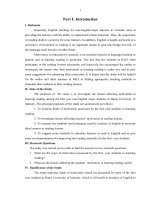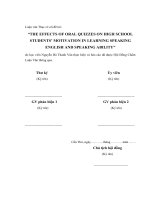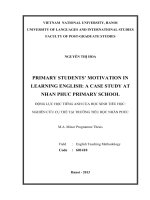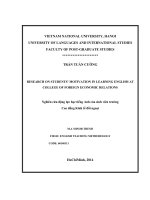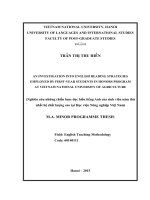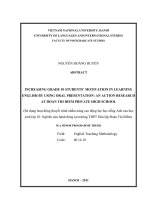Non english majored students motivation in learning english at vietnam national university of agriculture
Bạn đang xem bản rút gọn của tài liệu. Xem và tải ngay bản đầy đủ của tài liệu tại đây (430.41 KB, 66 trang )
VIET NAM NATIONAL UNIVERSITY OF AGRICULTURE
FACULTY OF EDUCATION AND FOREIGN LANGUAGES
BA THESIS
NON - ENGLISH MAJORED STUDENTS’
MOTIVATION IN LEARNING ENGLISH AT
VIETNAM NATIONAL UNIVERSITY OF
AGRUCULTURE
ĐỘNG LỰC HỌC TIẾNG ANH CỦA SINH VIÊN KHÔNG
CHUYÊN TIẾNG ANH: MỘT NGHIÊN CỨU TẠI HỌC
VIỆN NÔNG NGHIỆP VIỆT NAM
Student
: BUI BICH PHUONG
Student code : 621270
Major
: ENGLISH
Supervisor
:NGUYEN THI DUONG NGA, Ph.D
Hanoi – 2021
CERTIFICATE OF ORIGINALITY
I, the undersigned, hereby certify my authority of the study project report
entitled “NON - ENGLISH MAJORED STUDENTS’ MOTIVATION IN
LEARNING ENGLISH AT VIETNAM NATIONAL UNIVERSITY OF
AGRICULTURE” submitted in partial fulfillment of the requirements for the
degree of Bachelor in English Language. Except where the reference is indicated,
no other person’s work has been used without due acknowledgement in the text
of the thesis.
Hanoi, 2021
Bui Bich Phuong
Approved by
SUPERVISOR
(Signature and full name)
Nguyen Thi Duong Nga
Date:……………………
i
ACKNOWLEDGEMENT
Four years of sitting in a university lecture was a very arduous time but
also a lot of fun. During that time, I have gained a lot of valuable professional
knowledge as well as life experience that the teachers have enthusiastically
imparted and instructed. I would like to express my sincere thanks to the
teachers of the Vietnam National University of Agriculture in general and the
teachers in the Faculty of Education and Foreign Languages in particular for
dedicated teaching and providing me with knowledge and good luggage. most so
that I can firmly step into the future so that I can dedicate myself and contribute
to building the country.
I would like to send my sincere thanks to Ms Nguyen Thi Duong Nga,
Ph.D and Ms Ha Thi Lan, M.A, who have guided me throughout the internship.
Although you are busy with a lot of work, still do not hesitate to guide me so
that I can complete my essay in the best way. Once again I would like to
sincerely thank you two and wish you both good health.
I would like to thank my friends, brothers and sisters, and the library for
helping me in my practice time.
However, because of limited professional knowledge and lack of practical
experience, the content of the report cannot avoid shortcomings, I look forward
to receiving comments from teachers for the essay. This is more complete.
Thank you sincerely!
ii
ABSTRACT
This study aims to investigate the English language motivation of nonEnglish majors at Vietnam National University of Agriculture. The study used
survey a method by questionnaire. The questionnaire was designed based on
Doreen's (2003) three-scale model of learning motivation. Questionnaires are
designed and delivered to survey students via the link. The total number of
surveyed students includes 80 students of Vietnam National University of
Agriculture, belonging to many different faculties, classes, and academic years.
Through the research, the motivation of VNUA students did not have a big
difference between gender or faculty, major and place of residence.
Most
students are motivated to study because of career requirements, followed by
completion of courses.
Keywords: learning motivation, non - english majors, like-rt scale,
English.
iii
TABLE OF CONTENTS
CERTIFICATE OF ORIGINALITY...................................................................... i
ACKNOWLEDGEMENT......................................................................................ii
ABSTRACT.......................................................................................................... iii
TABLE OF CONTENTS...................................................................................... iv
LIST OF ABBREVIATION................................................................................. vi
LIST OF TABLES AND FIGURES....................................................................vii
PART 1: INTRODUCTION...............................................................................1
PART 2: DEVELOPMENT................................................................................9
CHAPTER 1: LITERATURE REVIEW...........................................................9
1.1. REVIEW OF PREVIOUS STUDIES ( AT HOME/ABROAD)....................9
1.2. REVIEW OF THEORETICAL BACKGROUND (DEPEND ON WHAT
THE STUDY IS ABOUT)................................................................................... 12
1.2.1. Definition of the motivation....................................................................... 12
1.2.2. Theory and principle of motivation............................................................13
1.2.3. Education motivation..................................................................................18
1.2.4. Types of learning motivation..................................................................... 19
1.2.5. Factors affecting student’s motivation in learning foreign language and
English.................................................................................................................. 23
1.3. SUMMARY...................................................................................................25
CHAPTER 2: METHODOLOGY....................................................................26
2.1. RESEARCH GOVERNING PRINCIPLES..................................................26
2.2. RESEARCH METHODS:.............................................................................29
2.2.1.Research setting/context..............................................................................29
2.2.2. Research methodology............................................................................... 29
2.2.3. Data analysis...............................................................................................30
2.3. SUMMARY...................................................................................................30
iv
CHAPTER 3: FINDINGS AND DISCUSSION.............................................. 31
3.1. MOTIVATION TO LEARN ENGLISH OF VNUA STUDENTS WITH
INTRINSIC AND EXTRINSIC MOTIVATION................................................31
3.1.1. Intrinsic motivation.....................................................................................32
3.1.2. Extrinsic motivation................................................................................... 34
3.2. MOTIVATION TO LEARN ENGLISH OF VNUA NON-ENGLISH
MAJORED STUDENTS THROUGH THREE TYPES OF MOTIVATION:
SELF MOTIVATION, CAREER MOTIVATION AND MOTIVATION OF
COMPLETE THE COURSE............................................................................... 36
3.3. FACTORS AFFECTING STUDENT MOTIVATION................................42
3.4. SUMMARY...................................................................................................46
PART 3: CONCLUSION...................................................................................47
1. RECAPITULATION........................................................................................47
2. CONCLUDING REMARKS........................................................................... 48
3. LIMITATION OF THE STUDY..................................................................... 49
4. RECOMMENDATIONS/ SUGGESTIONS FOR FURTHER STUDY.........49
REFERENCES................................................................................................... 50
APPENDIX..........................................................................................................52
v
LIST OF ABBREVIATION
ABBREVIATION
IELTS
L2
VNUA
CIED
EXPLANATION
International English Language Testing System
Second language
Vietnam National University of Agriculture
The Center for Foreign Languages and International
Education
vi
LIST OF TABLES AND FIGURES
Table 3.1: Motivation to learn English with intrinsic and extrinsic motivation: 31
Table 3.2: Intrinsic motivation with its criteria....................................................32
Table 3.3: Extrinsic motivation with its criteria.................................................. 34
Table 3.4: Motivation to learn English through motivation M1, M2, M3.......... 36
Table 3.5:Motivation M1, M2, M3 with criteria of gender and faculty.............. 38
Table 3.6: Motivation M1, M2, M3 with criteria of course and academic results
last semester..........................................................................................................39
Table 3.7: Motivation M1, M2, M3 with criteria of father’s and mother’s
occupation; and address........................................................................................41
Table 3.8: Factors affecting student motivation...................................................42
Table 3.9: Teaching method with its criteria....................................................... 43
Table 3.10: Parents with its criteria......................................................................44
Table 3.11: Learning attitude with its criteria......................................................45
vii
PART 1: INTRODUCTION
The first part is about the rationale for the study. Afterward, the aims and
objectives, research questions, scope, significance of the study are discussed.
The part ends with the design of the study.
1. RATIONALE FOR THE STUDY
In recent years, English as a foreign language has indeed developed
rapidly. It could be seen from the number of people who spoke English not only
as a tool to communicate with others, but also as an opportunity to achieve
success; success as a chance to maximize their competence and passion, either
in a job or career, education or life. In education, English could facilitate a
student to continue his or her education when studying abroad, achieve bachelor
or continue master and doctor. Lastly, English could expand friendships with
people in various countries.
Now, the boom of foreign investment companies in Vietnam has created
more and more job opportunities for graduates. Therefore, the need to
communicate in English at work has increased significantly. An appropriate
specialized English subject program to help students communicate effectively
for their future work is a pressing issue that every specialist English teacher is
concerned with. Former Prime Minister of Singapore Lee Kuan Yew once said:
"If all later Vietnamese students cannot speak English fluently, just reading it
would be lagging." According to the report of the Ministry of Education and
Training in 2017, after graduation, up to 51% of the students do not have the
English skills of the employer and need additional training. This has also been
recognized by leaders of many major universities that English is the weakest
student subject. According to statistics of the Ministry of Labor, War Invalids
and Social Affairs, in 2017, there were 237,000 unemployed bachelors and
masters. By 2018, Vietnam will continue to receive 200,000 unemployed
graduates. One of the reasons that graduates do not have a job is due to poor
1
English proficiency, inability to read and communicate in English. Mr Dao
Quang Vinh - Director of the Institute of Labor Science and Social Affairs
(Ministry of Labor, Invalids and Social Affairs) said that in 2019, the
unemployment rate will not have many new changes in Vietnam.
Many employers in Vietnam realize that the need to recruit positions is
very much, but they still cannot find suitable candidates because most of the
applicants' English is very poor. The reason is that many Vietnamese teachers
think that forcing students to copy many new words every day will memorize
and memorize them. Without knowing that, with this training method is not a
good method, because we have to imagine that when he was three children he
had to learn to speak from the beginning like "father, father", " mother, mother
", ... the native child must be like that, children have to call" mother "... and then
after speaking fluently, they switch to learning to write and read. Meanwhile, if
studying according to a standard English route, a person who loses English roots,
that is, has no vocabulary, does not speak English, and has poor grammar can
speak English fluently within 6 months. Learning the correct pronunciation,
imitating speaking like a native is considered the first route, like the foundation
of a house. After learners can speak standard English, basic communication or
advanced communication will be the wall and roof to take extra exams for
foreign certificates such as IELTS, Toiec,… completely easy.
Vietnam National University of Agriculture (VNUA) is a key national
university in human resource training and scientific research in agriculture and
rural development, increasingly diversified in fields of study with increasing
prestige in the Vietnamese higher education system. Vietnam National
University of Agriculture dates back to the date of establishment of Nong Lam
University on October 12, 1956. Vietnam University of Agriculture is located in
Trau Quy town, Gia Lam district, Hanoi. Located on a campus of nearly 200
hectares, the school has a system of lecture halls, modern laboratory and practice
2
facilities, spacious dormitories, a modern library system, a large fitness and
sports complex and many other important teaching , learning and research
facilities. VNUA is a large-scale multidisciplinary university with the current
number of staff and students at 1,344 people and about 20,000 people
respectively. It consists of 14 faculties , including Agronomy, Animal Science,
Fisheries, Veterinary Medicine, Environment, Land Management, Engineering,
Economics and Rural Development, Accounting and Business Management,
Faculty of Social Sciences, Food Science and Technology, Information
Technology, Biotechnology, Education and Foreign Languages. The university
has four Research Institutes: Agricultural Biology, Crop Research and
Development, Economics and Development, and Technical Research and
Training. The university has 22 Research and Service Centers, publishers and 2
companies (Ltd.). VNUA has 38 Undergraduate Programs, 34 Master Training
Programs and 17 Doctoral Training Programs. Besides the traditional
agricultural-related disciplines, VNUA has developed new training programs in
other fields in line with the trend towards a multidisciplinary university. In
particular, the University has built a number of advanced training programs and
joint training programs with foreign countries.
Up to now, VNUA has trained Laos 406 undergraduate students, 34
masters and 10 doctorates; for Cambodia, 56 graduates, 13 Masters and 9 Ph.
Many of these alumni have been holding key positions in agricultural agencies
and have made great contributions to the country's socio economic development.
Currently, there are nearly 100 Lao and Cambodian students studying at the
University, along with Chinese, Mongolian and African students and many
short-term internship students from other countries. Up to now, VNUA has
developed cooperation with more than 100 universities, foreign research
institutes and international organizations.
3
The Center for Foreign Languages and International Education (Center
for Foreign Languages and International Education) is a training unit under the
Vietnam National University of Agriculture, with the function of undergraduate
and graduate training in the fields of life sciences, social sciences, management,
economics and international relations,... CIED focuses and exploits highly
qualified human resources throughout the University, domestic and foreign
training institutions to participate in the training of a number of key disciplines
in foreign languages from which to build a standard and advanced training
model equivalent to other countries in the region and the world. Not only that,
the center also regularly organizes English exams for students of the whole
school in the format of B1, B2 of the European framework. Here, there are also
classes to improve the quality of English as well as review for students'
knowledge and skills before taking the exam.
Camelia English Center is located on the 1st floor of building D11, Dang
Xa urban, Gia Lam district, Hanoi. Founded in 2013, Camelia has grown
strongly and is a trusted English learning address for many people. Known as an
English center for children, Camelia has added many English communication
classes, suitable for a wide range of learners. Camelia English Center has two
main communication English courses for students and adults: Communicative
English for working people - for students who want to improve their English
skills as well as find good job opportunities; Basic communicative English - for
those who are not confident in communicating in foreign languages, or have lost
their roots.
PPS Vietnam Center is located at 129, Street 2, Cuu Viet, Gia Lam,
Hanoi. PPS Vietnam English Center was established in 2011 with a team of
excellent teachers and internationally recognized pedagogical experience. PPS
Vietnam has become one of the prestigious English language centers in Hanoi in
the field of English training and teaching. In particular, in communication
4
courses, students will regularly interact with experienced native teachers,
building confidence in speaking and listening to foreign languages and can
practice pronunciation.
With the motto of English training focusing on people who have lost their
roots, promoting the spirit of learning English, the motivation to learn English
are the methods that Nasao English Center - English Center in the area of
Agricultural Academy is applying. In particular, 100% of this method is
developed keeping the core spirit: motivation to learn English, dare to speak
English, focus on pronunciation, effective use of vocabulary-grammar and group
study. Maintaining the spirit of learning English, focusing on pronunciation,
focusing on motivation, the English center in the area of Vietnam National
University of Agriculture - Nasao English has become a prestigious place for
agricultural students to study.
The English modules in the curriculum are divided into basic English and
professional English. In the basic course, it is usually divided by the level of
English 0, English 1, English 2,... Additional English, and specialized English.
Listening, Speaking, Reading and Writing sections from A2 to B2 are divided
into semesters, then students will be taught and practiced translation and
interpretation subjects as well as teaching in professional English. Beside that,
students can also participate in classes at the CIED Center to supplement their
English skills and have the opportunity to work here to be able to receive
scholarships to study abroad according to the policies of the University. Highquality advancement programs are also organized by the school more and more
closely with the aim of bringing in more students with solid majors combined
with European B2-standard English skills, bringing many talents to help the
country.
Students studying at universities often come from different regions of the
country, and may even be international students. Establishing appropriate
5
teaching methods is also a big challenge for each teacher. Because not all
teachers can control well the cases that can happen unexpectedly. Below are
some methods commonly used in classrooms at VNUA.
-Visualization: teachers often prepare word matching games with
corresponding pictures. From there, give definitions to help students easily
remember words, easy to associate. In addition to rendering images, this method
can also use video or audio clips. Or another way is to choose students to guess
the word, and other students will below give suggestions in English. This
requires students' preparation in advance because not every word can be guessed
by students if they don't know it.
- Cooperative learning: This method is geared towards student engagement,
encouraging students to work together by promoting small group or whole class
activities. Expressing opinions and views will help students become more confident,
improve their communication and critical skills in English.
- Inquiry-based instruction: With this method, teachers can give articles
or small excerpts in English and ask students to read them. Then, students will
answer the thinking questions posed by the teacher. This will stimulate students
to think and think. Besides, students can also ask questions to answer questions
if any. This process helps students improve their problem-solving skills.
-Technology in the classroom: Combining teaching with modern
technology is a widely used method today. This not only saves time such as
writing on the board, but also helps teachers to offer more activities by showing
activities, or content to students. Video recording or presentations using powerpoint is also the main teaching method. Students will self-study the lesson, and
present it to their classmates, the gaps in the content will be supplemented by the
teacher. Therefore, learning will revolve around the self-discipline of students
and no longer depend on teachers.
6
At Vietnam National University of Agriculture, as a training institution
with multidisciplinary students, students studying here can work for the private
and public sectors. Therefore, it is important to understand student’s motivation
in learning English, then find solutions to increase their motivation in learning
English, contributing to higher quality of students, especially those who are
graduating.
2. AIMS AND OBJECTIVES OF THE STUDY
The study aims to understand the motivation of students in amateur
English at Vietnam National University of Agriculture and propose some
recommendations for English teaching programs in Vietnam National University
of Agriculture to increase student’s motivation in learning English. Specifically,
the study designed to:
+ Contribute to literature review on student’s motivation in learning
second language generally, and English specifically;
+ Evaluation and survey of English language motivation of students at
Vietnam National University of Agriculture;
+ Propose key recommendations to improve student’s motivation in
learning English in Vietnam National University of Agriculture.
3. RESEARCH QUESTIONS ( IN FORM OF QUESTIONS)
The purpose of this study is to survey the motivation to learn English of
non-English majors at Vietnam National University of Agriculture in order to
find out and offer solutions to improve the quality of teaching and learning here.
The researcher investigates the issue through three research questions:
- What are the types of students' motivation to learn English?
- Which is the student's motivation in learning English at Vietnam
National University of Agriculture?
- What are key solutions to motivate students in learning English at
Vietnam National University of Agriculture?
7
4. SCOPE OF THE STUDY
The study focuses on non- English major student’s motivation in learning
English and is conducted in Vietnam National University of Agriculture.
Primary data is collected in 2021.
5. SIGNIFICANT OF THE STUDY
This study is expected to contribute to better understanding of the
motivation of students in learning English at Vietnam National University of
Agriculture and provide some key recommendations to increase their motivation
in learning English at the university.
6. DESIGN OF THE STUDY
The research report will be organized in three parts as follows:
Part 1: INTRODUCTION
includes rationale, aims of the study, research
questions, scope of the study, significance and design of the study
Part 2: DEVELOPMENT is divided into 3 chapters:
Chapter 1: LITERATURE REVIEW introduces theoretical background of the
study with the clarification of the constructs via relevant theories. This chapter
also reviews previous studies related to this research.
Chapter 2: METHODOLOGY specifies methods of data collection and data
analysis.
Chapter 3: FINDINGS AND DISCUSSION – analysis of the data achieved and
discussion of the results obtained after the survey.
Part 3: CONCLUSION conclusion about the results achieved after research.
8
PART 2: DEVELOPMENT
CHAPTER 1: LITERATURE REVIEW
This chapter will review previous studies. Beside that, it will describe and
define the basic concepts of motivation, classify the basic types of motivation,
and learn about the factors that affect the learning motivation of students of the
Vietnam Academy of Agriculture.
1.1. REVIEW OF PREVIOUS STUDIES (AT HOME/ABROAD)
The study is about student’s motivation in learning Chinese - Banking
University of Ho Chi Minh City shows that students have relatively positive
learning motivation. It was based on the theory of the three domains of foreign
language mechanics introduced by Dornyei in 1994 including language range,
learner scope and learning environment. The questionnaire included 32
questions with the content "Why do you learn Chinese". The results show that
students choose Needs tourism/career = Real value of self > Excitement of
language = Excitement of culture, politics > Requirements of other people =
Demand for communication. We can see that BUH students learn mainly from
their own individual needs.
According to the research of Dr. Nguyen Van Luot, Deputy Head of
Psychology Department, University of Social Sciences and Humanities,
Vietnam National University, the English motivation of Binh Dinh College
students is low. Students' learning is still coping with a lot, in particular, the
percentage of students who retake this subject is the highest among all subjects
in the training program, accounting for 21.5%. Here, the author has considered
by 8 criteria such as gender, faculty / discipline, school year, learning results,
time of study, age, parents' occupation and place of residence and made a
conclusion of learning activities students are motivated by many different
motives, of which the most dominant is the "Complete course", then "Satisfy
career requirements", and the lowest is "Self-affirmation. ".
9
Munir Shuib conducted a survey to identify Petroleum Engineering
students’ motivation and attitudes towards learning the English language. The
study investigated students’ motivation in terms of three motivational constructs:
instrumental motivation, integrative motivation and personal motivation based
on Gardner’s (1985) and Cooper and Fishman’s (1977) works. The study sample
consisted of 81 petroleum engineering students at Hadhramout University of
Sciences and Technology (HUST). For the students’ motivation, the results
indicated that a high number of the students showed their interest in the culture of
the English speaking world as represented by English-language films.
Azizeh Chalak, Zohreh Kassaian investigated the various sociopsychological orientations of Iranian undergraduates towards learning English.
It focused on the motivation orientations of the students and their attitudes
towards the target language. The survey was conducted on a group of 108
students majoring in English translation at Islamic Azad University, Iran. The
domains used for the purposes of the study were interest in English, parental
encouragement, motivational intensity, attitudes towards learning English,
attitudes towards English-speaking people, integrative orientation, desire to
learn English, and instrumental orientation. Through 5 questions, the results
revealed that these Iranian were highly positive in learning English.
Another study investigated Taiwan university students' English language
orientation from the perspective of the key L2 dynamics concepts differ and the
concept of English is the international language. The study involved 267
undergraduates from a science and technology university in New Taipei City,
Taiwan. The results showed that there was no difference between a student's
motivation in learning English during day and night through 7 aspects:
Integrative, Instrumental, Intrinsic, External, Ideal, Ought, Travel.
The study by Chunmei Long and Zhu Ming "The Study of student
motivation on English learning in Junior" surveyed Gejiu junior high school
10
students with the aim of finding out the adverse factors and giving some
suggestions to stimulate learning motivation in students. Through the study, the
number of survey participants said that they spend half an hour learning English
every day, only 3.3% of them spend more than an hour learning English. 36.7%
showed that goal setting is the main factor of students' motivation to learn
English and 23.3% of students can strive for that set goal. Most students expect
to get high marks in English learning, accounting for 36.7%. 53.3% of students
realize the importance of learning English, but 56.7% of students do not have a
sense of self-study. From the above data, it can be seen that students are always
aware of the importance of learning English, but they still do not know how to
set goals for themselves, and do not have the self-discipline to complete the set
goals. The important thing is to be able to help students set goals and guidelines,
guide methods to achieve success and subsequent results. From there, student
motivation can be enhanced.
According to "The study of motivation and strategies in learning of
English by middle-aged and elderly in China" by Fu Yezhi (2016), the author
points out that nowadays there are a little studies focusing on middle-aged and
elderly, and there is a lack of comparisons between studies on learning
motivation, strategic motivation, and learning barriers of middle-aged and
elderly. Therefore, the aim of this study was to analyze the differences in the
motivations, learning strategies, and learning barriers of middle-aged and elderly
people. According to the survey, most learners have a clear motivation to learn.
They can realize the importance of learning English. The level of English
motivation of junior high school students is not high, in general, it is usually
learning to cope, learning to pass exams. Students mostly focus on problemsolving skills to cope with the test. Therefore, students' main concern is English
learning achievement and how to pass the exams. Since then, the student's
motivation or learning goal has changed.
11
1.2. REVIEW OF THEORETICAL BACKGROUND (DEPEND ON WHAT
THE STUDY IS ABOUT)
1.2.1. Definition of the motivation
Motivation plays a big role in engaging students to learn. As schunk said
"Motivation can influence what, when and how we learn (as cited in Pintrinch,
2008, p.5)". If students had motivation in learning whether intrinsic or extrinsic,
they could independently decide what they had to learn, the length of time that
they needed to spend, and what are the techniques that helped them to
understand the subject easily.
Motivation is understood as an active psychological manifestation in
relation to needs and excitement. Demand is the inescapable demand that people
see the need to satisfy certain conditions in order to survive and grow.
Excitement is an individual's special attitude towards a certain object. In
psychology, there are many different notions about human motivation, but the
common point in the views on these psychological phenomena is to consider
motivation as orientation, stimulation, and motivation.
Crookes and Schmidt (1991) define “Motivation as the learner’s
orientation regarding the goal of learning a second language”. According to
Ellliot and Covington (2001), “Motivation gives the reasons for people's actions,
desires, and needs. Motivation can also be defined as one's direction to behavior
or what causes a person to want to repeat a behavior and vice versa”. Pardee
(1990) said that “Motive is what encourages the person to act in a certain way or
develop an inclination for particular behavior”. According to Gardner (1985),
“Motivation is the combination of attempt plus desire to obtain the aim of
learning the language plus favorable attitudes toward learning the language.
Oxford and Shearin (1994) defined “Motivation as a desire to gain an objective,
combined with the energy to work towards that objective”. Narayanan (2006)
12
said that “Motivation is the reason or reasons behind one's actions or
behaviors”.
Emily R. Lai (2011) defines “Motivation refers to reasons that underlie
behavior that is characterized by willingness and volition. Intrinsic motivation is
animated by personal enjoyment, interest, or pleasure, whereas extrinsic
motivation is governed by reinforcement contingencies. Motivation within
individuals tends to vary across subject areas, and this domain specificity
increases with age. Traditionally, educators consider intrinsic motivation to be
more desirable and to result in better learning outcomes than extrinsic
motivation”.
N., Pam M.S (2013) defines “Motivation is the driving force behind the
energy required to complete a task, a lack of motivation will give rise to a lack
of driving power behind completing a certain task”.
Baumeister (2016) said that “Motivation has as many faces as there are
human desires. The simplest definition of motivation boils down to wanting”.
1.2.2. Theory and principle of motivation
There is a view that man is a creature whose intellectual action is
dominated by emotions. Many studies have been done (Gardner, 1985; Reid,
1999; Dörnyei, 2005;.....) and confirm the success or failure of language
learning manifests both in perception, consciousness and emotions.
Motivation has occupied an important position because this is one of the
influencing factors at a certain level of awareness. Determining the right
engine is very complicated. Dörnyei (2001) calls it "a real mystery" that,
despite extensive research, cannot give an exact definition. Historically,
theories of motivation have been divided into: psychosocial stage (19591990), cognitive orientation (in the 1990s), process orientation, and social
stage. most recent dynamic period.
13
In the psychosocial period, Wallace Lambert, Robert Gardner and other
social psychologists in Canada are extremely interested in motivation and
emotional factors. The social education model (Gardner, 1985; Gardner &
MacIntyre, 1993; Gardner, 2001; 2007) was created and has dominated the field
for over 40 years. Gardner and his colleagues consider L2 as a mediator between
different communities. According to them, language learning is rooted in society,
and each individual needs to develop a different L2 identity, and a learner's
motivation is determined by two factors: attitude and orientation towards L2
learning. Therefore, they argue that the concept of motivation includes goals,
desires, efforts, and positive attitudes (Gardner, 1985). The two constructs of
Gardner's motivation theory are integrative and instrumental.The first
orientation concerns the motivation to learn a second language, while the second
reflects the practical value and advantages of learning a new language.
Integrative motivation includes integrativeness, attitudes towards learning, and
motivation.
AMTB (Gardner, 1985) is a tool designed to measure several dimensions
of formation in the social education model. The three evaluation scales are
attitude towards goals, interests and integrated orientation. Intensity, attitude
towards language learning, and desire to learn languages
are measures of
motivation. Attitudes to teachers and to the course are two scales that look at
the learning situation, which is a person's reaction to the current learning
situation. From Gardner's AMTB, Mihaljević Djigunović (1997, 1998) designed
a questionnaire to measure the types and intensity of motivation. In contrast to
Gardner & Lambert (1972), three types of motivation were found. Affective
motivation refers to a learner's desire to learn English for specific aesthetic or
emotional reasons. The pragmatic communicative dynamics combine with the
instrumental and professional value that learners attach to their knowledge and
status of English as an international language of communication. Finally,
14
inclusion motivation reflects the learner's desire to be integrated into the
English-speaking cultural and linguistic community. Communicative-pragmatic
motivation plays an important role in academic success. As new theories
emerged, the influence of Gardner's theory did not wane because it was the
starting point for much of the later conceptions of motivation.
The focus gradually shifts to exploring cognitive motivations, such as the
teaching environment, to learners' motivations.
It requires extending the
existing theoretical framework. Attribution theory (Weiner, 1985, Julkunen,
1989; Dörnyei, 1990; Ushioda, 1998) distinguishes between factors external or
internal, stability, and personal control. In addition, other possible causes of
success or failure are ability, task difficulty, effort, and luck. In the classroom
setting, learners' beliefs about achievement or mastery will influence actual
learning.
For example, people who believe that achieving a high score is
impossible to achieve are not going to put in as much effort to achieve it or give
up as much as those who hold the opposite belief.
Proposed by Deci & Ryan (1985), self-determination theory distinguishes
two types of motivation as intrinsic and extrinsic. Self-determination is defined
as "the functioning human quality related to the experience of choice" (Deci &
Ryan). Focusing on aspects of the situation opens up new avenues of inquiry:
task-related motivation (Julkunen, 2001; Dörnyei, 2002). The complex dynamic
results of a number of contextual influences and factors within the learner
interacting with the intrinsic matching relationships of the task. Continual
change also depends on the learner's stages of implementation, evaluation, and
monitoring. Dörnyei's (1994) explains motivation in three main dimensions,
which are also three levels. The language level includes aspects such as culture
and community. Next is the learner level, which includes the individual
personality of each person. Finally, the learning situation. It may include the
classroom setting and other components such as curricula, teaching materials,
15
methods, etc.). Teachers have a certain influence on student motivation such as
goal setting, reward, class structure and group cohesion. Having a change in the
parameters to some degree can affect the overall dynamics. An individual's
motivation to learn a foreign language is influenced by contextual and social
factors. Internal factors include intrinsic preferences, perceived value of
activities, sense of self-management, mastery, self-concept, attitude, emotional
state, age of development, etc... External factors include important people such
as parents, teachers, colleagues. Williams and Burden (1997) were the first to
argue that motivation is a continuum of stages from arousing interest to
maintaining interest, morale, and effort. However, Dưrnyei & Ottó (1998) L2
dynamical process model detailed the oscillations of L2 dynamics by focusing
on dynamics as a continuously changing dynamic structure and influencing
successful learners. Motivation is defined as arousing change in a person,
directing and coordinating, amplifying, terminating and evaluating. In the three
stages, the main motivational influences also change. At the preparatory stage,
motivation is influenced by goal attributes and attitudes. By the active stage, the
quality of the learning experience, the sense of autonomy, of social influences,
may be affected. Finally, the main motivational influences are self-belief,
external judgment, and achievement scores. The value of this model lies in
describing changes in dynamics and possibly over longer time periods. Even so,
Dörnyei still argues that it cannot "do the complexity of dynamical system
justice". The change of opinion has moved the study of L2 dynamics to a new
theoretical stage that Dörnyei and Ushioda (2011) call the social dynamics stage.
In view of the relationship between people and the context of motivation,
Ushioda (2009) focuses on developing the relationship between motivation, self,
and context. This system therefore consists of three parts: L2 Ideal Self, L2
Right Self, and L2 Learning Experience. The L2 itself is perceived as a living
and real image that one can see, hear and feel. Learners desire to learn L2 to
16
achieve their desires. L2 itself is a product of learners' obligations, expectations
and responsibilities from society. Dörnyei & Ushioda (2011) argue that L2
dynamics are beneficial to the analysis of these aspects because of its everchanging fundamental nature.
The concept of first principles was introduced by Merrill (2002) to refer to
the compulsory learning principles common to theories of instructional design.
The five principles of motivation can be explained as follows:
(a) Motivation to learn is boosted when learners are aware of gaps in current
knowledge. Research on curiosity, arousal, and boredom (Berlyne, 1965; Kopp,
1982) shows that it is extremely important to use different methods to capture
learners' attention. The higher the level of attention, the more stimulating the
learner's sense of inquiry is. Without a certain strategy, even if they attract
attention, they will still lose interest over time. Therefore, it is important to take
different approaches and make appropriate changes to the level of stimulation.
(b) Motivation to learn is promoted when that knowledge is relevant to the
learner's goals. The learner's goals may depend on the learner's future desires
and intentions, but the level of motivation depends on the learner to decide on
his own. It is common to call learning activities that have a lot to do with the
applied context as authentic learning experiences.
(c) Motivation to learn is promoted when learners believe that they can succeed
in successfully completing their learning. Confidence is gained by helping
students
build
positive
pathways
and
then
experience
their
own
accomplishments and efforts rather than by luck or difficulty in doing so.
Achievement that is perceived as the result of luck or an easy goal is unlikely to
increase a student's confidence.
(d) Motivation is boosted when learners predict the outcome of a leap task. The
first three principles are necessary conditions for establishing student motivation
to learn, but the fourth principle represents satisfaction, which is the positive
17
